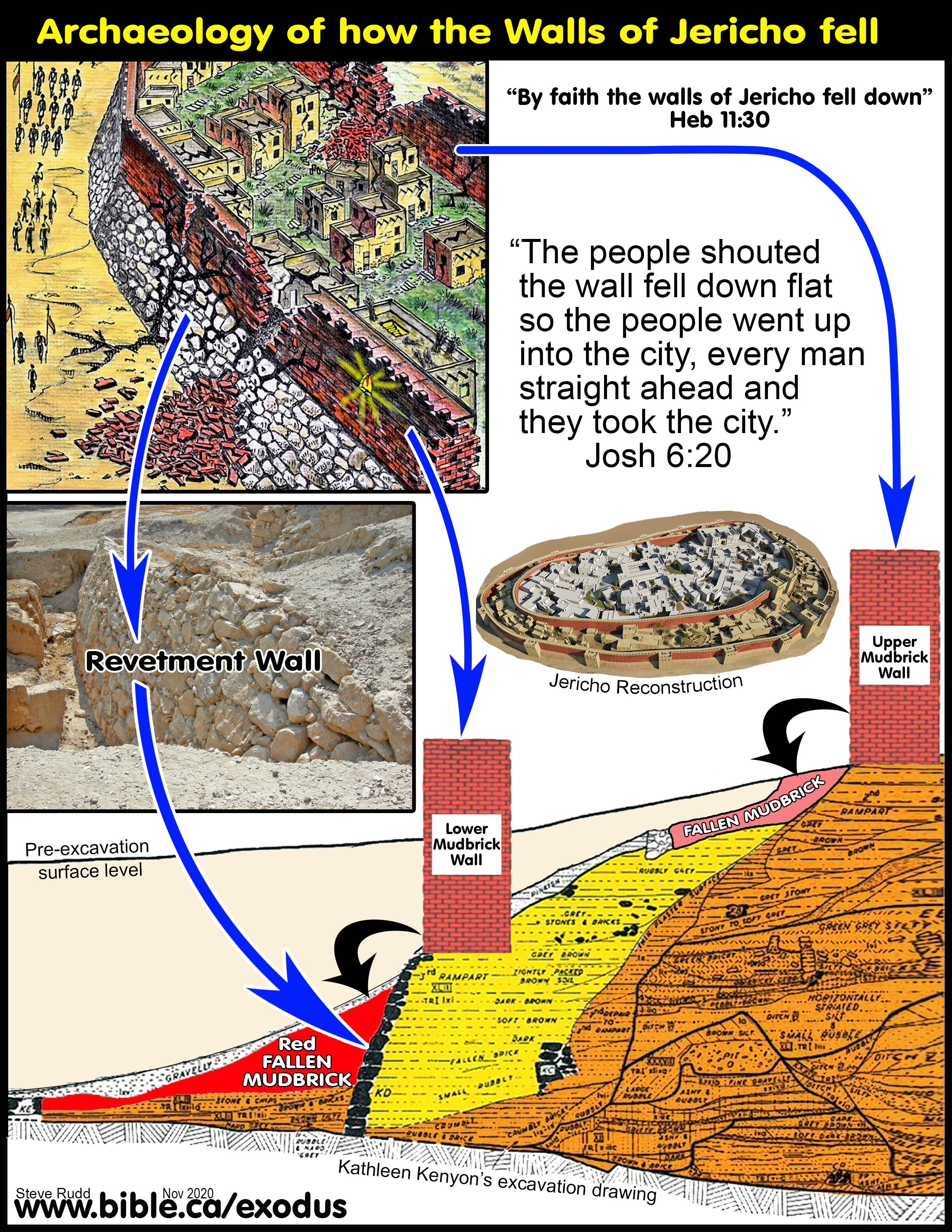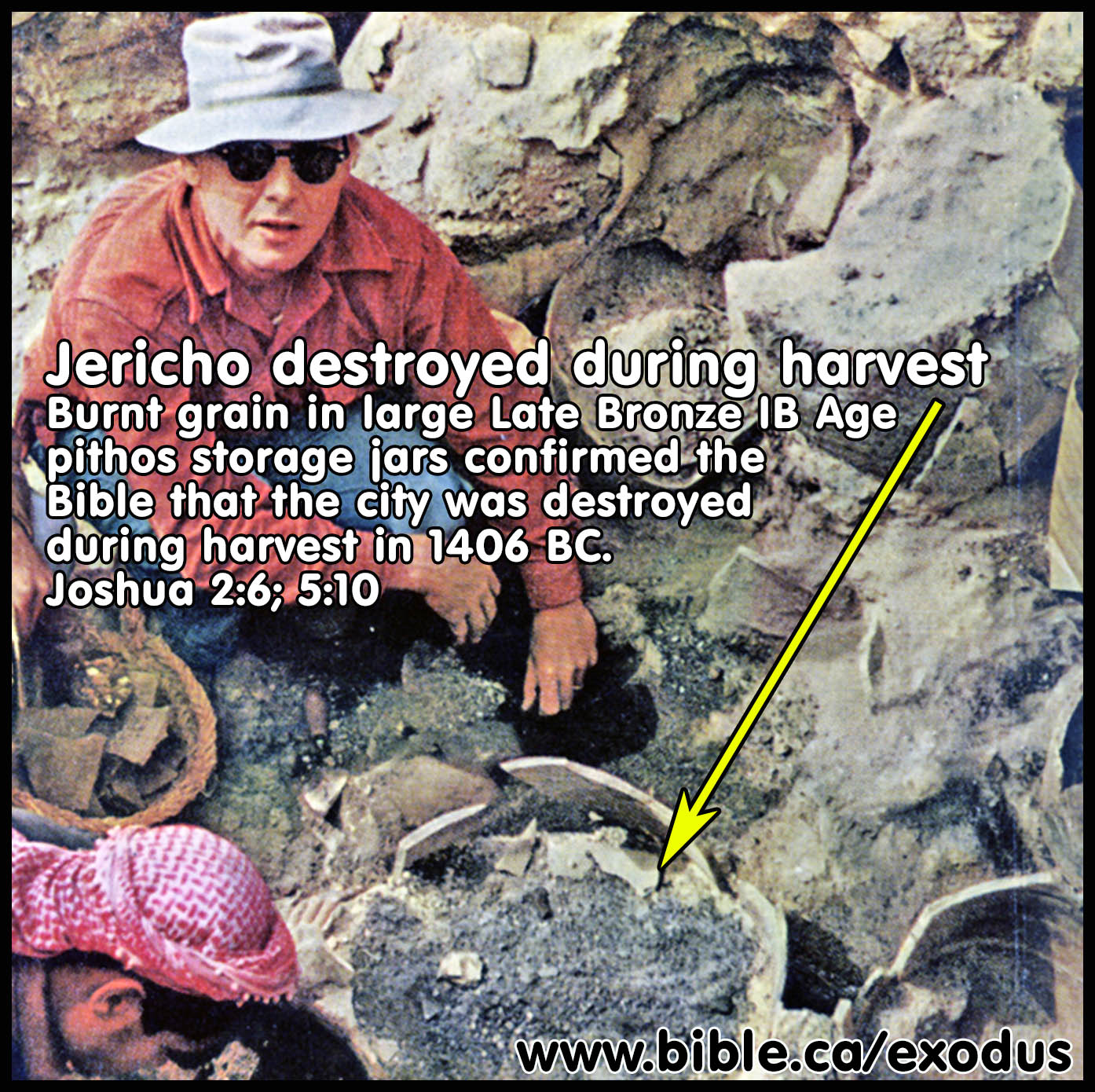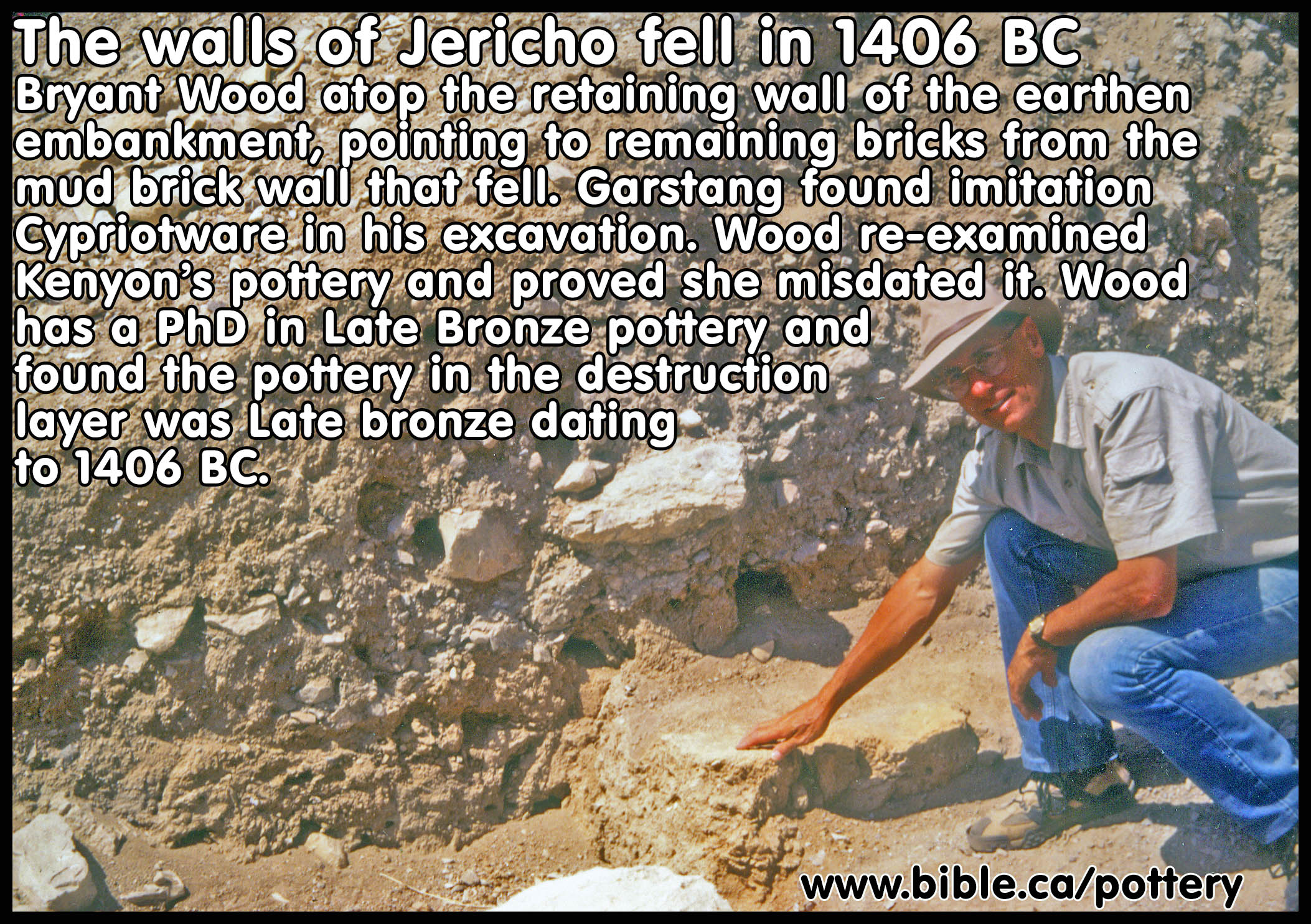Conquest of Jericho “and the walls came tumbling down” in 1406 BC
Archaeological confirmation of the Bible account of Joshua’s conquest
Most striking is the archeological discovery of fallen
mudbricks below both the lower and upper walls,
which enabled the Hebrews to walk directly up into the city just as the Bible says!
“What you read in the Book you find in the ground!”
A. Biblical Jericho:
1. The Bible records that God caused the walls of Jericho to fall in 1406 BC under the leadership of Joshua. Next to fall was Ai. It took three years to subdue the south and three more to subdue the north. The six-year conquest ended in 1400 BC. During the first sabbatical year in 1300 BC, the tabernacle tent was moved from Gilgal to Shiloh in 1399 BC where it was in service for 305 years until the philistines captured the Ark of the Covenant in 1094 BC.
2. Jericho was a “first fruits” city:
a. God did not permit the Hebrews from looting any of the goods at Jericho because God decreed the wealth of the city was to be a “first fruits” offering to God (Joshua 6:17-19).
b. In Joshua 7, Achan violated the ban by coveting gold and silver in his tent which was why the first attempt to take Ai failed.
c. “Both Garstang and Kenyon found many storage jars full of grain that had been caught in the fiery destruction. This is a unique find in the annals of archaeology. Grain was valuable, not only as a source of food, but also as a commodity which could be bartered. Under normal circumstances, valuables such as grain would have been plundered by the conquerors. Why was the grain left at Jericho? The Bible provides the answer. Joshua commanded the Israelites that the city and all that is in it were to be dedicated to the Lord.” (The Walls of Jericho, Dr. Bryant wood, Creation 21.2, p38, 1999 AD)
3. Jericho was a strong city fortified with double walls: Joshua 6:3-5
a. "Nevertheless, the people who live in the land are strong, and the cities are fortified and very large; and moreover, we saw the descendants of Anak there." (Numbers 13:28)
b. Most striking is the archeological discovery of fallen mudbricks below both the lower and upper walls, which enabled the Hebrews to walk directly up into the city just as the Bible says!
a. “The mound, or “tell” of Jericho was surrounded by a great earthen rampart, or embankment, with a stone retaining wall at its base. The retaining wall was some four to five meters (12–15 feet) high. On top of that was a mudbrick wall two meters (six feet) thick and about six to eight meters (20–26 feet) high. At the crest of the embankment was a similar mudbrick wall whose base was roughly 14 meters (46 feet) above the ground level outside the retaining wall (see diagram). This is what loomed high above the Israelites as they marched around the city each day for seven days. Humanly speaking, it was impossible for the Israelites to penetrate the impregnable bastion of Jericho.” (The Walls of Jericho, Dr. Bryant wood, Creation 21.2, p36, 1999 AD)
4. Joshua’s 7-day siege of Jericho was unusually short, indicating divine intervention:
a. “Such a large quantity of grain left untouched gives silent testimony to the truth of yet another aspect of the biblical account. A heavily fortified city with an abundant supply of food and water would normally take many months, even years, to subdue. The Bible says that Jericho fell after only seven days. The jars found in the ruins of Jericho were full, showing that the siege was short since the people inside the walls consumed very little of the grain.” (The Walls of Jericho, Dr. Bryant wood, Creation 21.2, p39, 1999 AD)
B. Archeology confirms Jericho was destroyed by Joshua in 1406 BC:
|
Five Archaeology Confirmations of the bible’s account of the conquest of Jericho |
||
|
|
Bible |
Archaeology |
|
A fortified city |
Walled city: Joshua 6:3-5 |
Visitors to Jericho today can confirm that it was a walled city with their own eyes. |
|
City was burned with fire |
"They burned the city with fire, and all that was in it. Only the silver and gold, and articles of bronze and iron, they put into the treasury of the house of the Lord." (Josh 6:24) |
“The destruction was complete. Walls and floors were blackened or reddened by fire, and every room was filled with fallen bricks, timbers, and household utensils; in most of the rooms the fallen debris was heavily burnt, but the collapse of the walls of the eastern rooms seems to have taken place before they were affected by the fire.” (Kathleen M. Kenyon, Excavations at Jericho 3: 370) |
|
Destroyed during harvest |
Passover is harvest time: Josh 2:6 Rahab was drying flax: Josh 5:10 |
|
|
Unusually short 7-day siege |
7 days: Heb 11:30. The large quantity of grain found proves the siege was short because, so little was eaten. Fortified cities often took years to conquer through siege. Cities stored food to protect from siege: (Judges 6:4). Cannibalism was reported in both multi-year sieges of Jerusalem in 587 BC and AD 70. Ezek 5:10; Jer 19:9; 2 Ki 6:24-30; Jos. Wars 6.193-217. “Such a large quantity of grain left untouched gives silent testimony to the truth of yet another aspect of the biblical account. A heavily fortified city with an abundant supply of food and water would normally take many months, even years, to subdue. The Bible says that Jericho fell after only seven days. The jars found in the ruins of Jericho were full, showing that the siege was short since the people inside the walls consumed very little of the grain.” (The Walls of Jericho, Dr. Bryant wood, Creation 21.2, p39, 1999 AD) |
|
|
City not plundered highly unusual |
First fruits “Ban” on looting: Josh 6:17-19. Grain was so valuable that armies would specifically attack shortly after harvest to loot the grain. The large quantity of grain found in excavations proves the city was not looted of its food which is highly irregular. |
|
C. John Garstang’s archaeological excavations at Jericho: AD 1930-1936
1. John Garstang excavated Jericho 1930-1936 and concluded Jericho was destroyed in 1406 BC, confirming the Bible. Garstang documented imitation Cypriot ware pottery from the late 15th century BC he found at Jericho.
2. While Garstang made a few errors, typical of the infancy of the science of archeology of his day, his overall conclusions were sound and correct.
D. Kathleen Kenyon’s archaeological excavations at Jericho: AD 1952-1958
1. Kathleen Kenyon excavated Jericho in 1952–58 and wrongly concluded that the walls of Jericho fell around 1550 BC, which was 150 years before the Bible says they did in 1406 BC. Kenyon pioneered the stratified excavation process, and her field work was excellent, but her lack of education, background, training and proper credentials led her to formulate unsubstantiated theories and conclusions, most of which were later rejected. However, her theory that the walls of Jericho fell in 1550 BC has been widely accepted.
2. Pottery is one of the key methods of dating an ancient, ruined city like Jericho and Kenyon had no training or experience in dating Late Bronze age pottery. Whereas most professional excavation reports have many pages of detailed written analysis, in Kenyon’s final excavation report, she did not do an analysis of her pottery, she simply compared it with pottery she had excavated from tombs at Jericho. This is a highly subjective and erroneous methodology. Kenyon’s own editor of the volume said, “Comparative studies of the material with that from other sites…will be necessary before a satisfactory interpretation of these vessels can be made” (Kathleen M. Kenyon, Excavations at Jericho 4:269).
3. Kenyon rejected the Bible account of the conquest of Jericho under the leadership of Joshua, primarily because no Cypriot pottery was found. She then ignored the fact that Garstang had found imitation Cypriot pottery during his excavations of Jericho in the 1930's, which he published in his archaeological reports.
4. Kenyon’s lack of training and credentials led her to misread the pottery she excavated to 1550 BC. Kathleen Kenyon was a vocal Bible-hating skeptic, so it is no surprise she drew conclusions that she knew destroyed the inspiration of scripture.
E. Dr. Bryant Wood reevaluated the Late Bronze pottery Garstang and Kenyon published
|
Dr. Bryant Wood has a PhD in Late Bronze pottery and noted that Garstang had found "Imitation Cypriot ware" pottery on the east side of the tell. When Wood reexamined Kenyon's misdated pottery, he proved her dating conclusions wrong. Wood confirmed the work of Garstang and refuted Kenyon’s conclusion that the Bible story was a myth. Based upon the science of archaeology, Bryant Wood gave Jericho back to Bible believing Christians who can now be certain that the walls of Jericho fell in 1406 BC, exactly when the Bible says they did. It is unfortunate that most Bible encyclopedias, dictionaries, and reference works still support Kenyon’s date for the destruction of Jericho and note it is at variance with scripture, unaware Wood solved this decades ago and proved the walls of Jericho “came tumbling down” in 1406 just like the Bible says. |
Conclusion:
1. The Bible story of Jericho is one of the most widely known and taught stories.
a. Children sing the song from the youngest ages: “And the walls came tumbling down”.
b. Preachers use the story of Jericho as a model of living by faith.
2. The story of Jericho is widely hated and mocked by Bible scoffers like many other similar stories:
a. Adam and Eve in the garden of Eden
b. The exodus, 10 plagues of Egypt, crossing the Red and Mt. Sinai.
c. Jonah swallowed by a sea monster.
d. Jesus rising from the dead.
3. Kathleen Kenyon was a Bible hater who delighted in concluding the walls of Jericho fell over 150 years before Joshua was supposed to arrive in 1406 BC.
a. Professional archeologists, most of whom are also atheist bible scoffers, immediately jumped on board and pointed out the science of Archaeology has proved the Bible to not be a reliable book of history.
b. This led preachers in the 1950’s and 1960’s to view archaeology like evolution and avoid both in the pulpit.
c. To this day most reference books quote Kenyon as proving the Bible wrong because “when Joshua arrived, there were no wall for him to make fall down”.
4. Dr. Bryant Wood was an expert in Late Bronze pottery whereas Kenyon had almost no knowledge and training in pottery as reflected in her published reports.
a. Wood reexamined the pottery from Jericho and was able to confirm Garstang’s original date of 1406 BC and refute Kenyon’s date of 1550 BC when the walls of Jericho fell.
b. Dr. Wood not only gave Jericho back to Christians, he proved to preachers that archeology is a valid science that confirms the historical accuracy and inspiration of the Bible.
c. Thankyou Dr. Bryant Wood for your tireless efforts to prove that “what you read in the Book you find in the ground”.
5. It is a shameful disgrace that Bible encyclopedias, dictionaries and reference works continue to rely on Kenyon instead of Dr. Bryant Wood to show that the science of archaeology confirms the Bible when the walls of Jericho fell in the spring of 1406 BC.
By Steve Rudd: Contact the author for comments, input or corrections.



